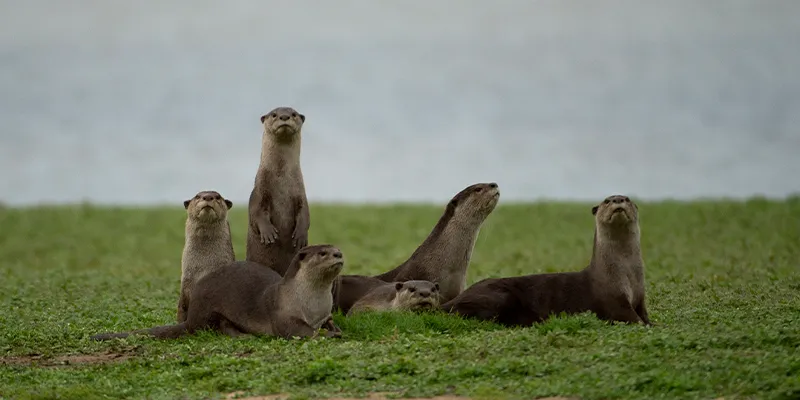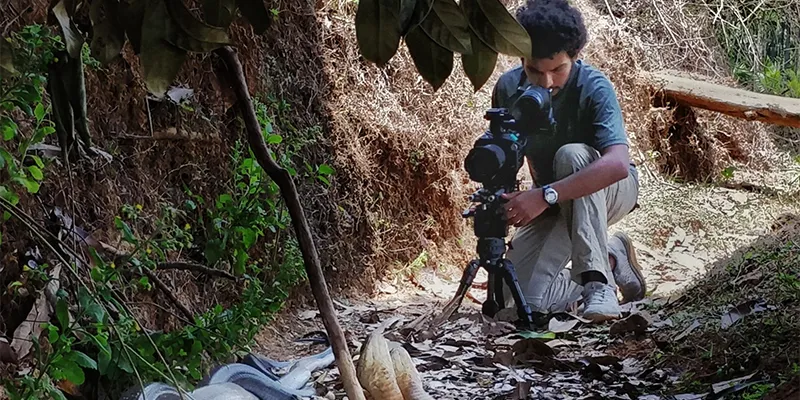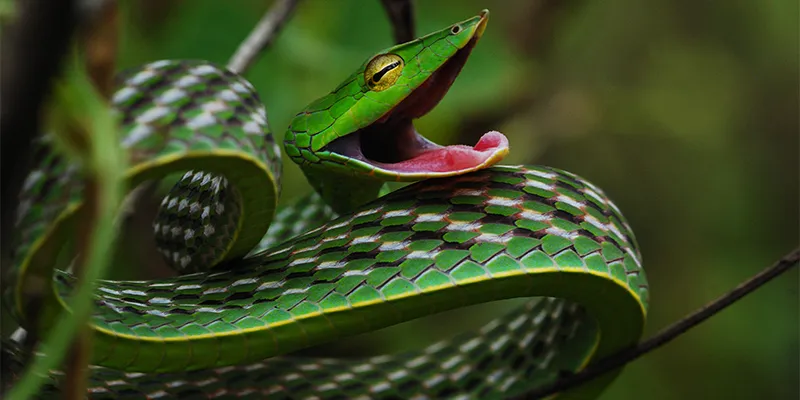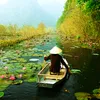1,500 days, 15,000 hours and 2,400 minutes of footage: How Wild Karnataka, captured the majesty and beauty of the state
Wild Karnataka, a movie, created by award-winning filmmakers is a big hit among those who love animals and the grandeur of the beautiful landscapes. Here’s what the filmmaker has to say…
Imagine the stunning footage of otters chasing tigers, a clip of dancing frogs or a magnificent overview of a leopard hunt, captured in a dazzling minute-by-minute format.
Imagine these splendid creatures against the different kinds of forests, ranging from the wet evergreen forests of the Western Ghats, to the deciduous forests of Mysore to the thorn scrub forests and rocky outcrops of Ramnagar and Daroji. It is all this and much more that went into the making of Wild Karnataka, a movie that is now in the theatres and has proven to be a visual treat for Indian film viewers.
Since the opening weekend, PVR has added three times the original slated shows to the roster in South India to accommodate the growing demand for the film. It has been decided that the monetary returns beyond the expenditure made by the contributors will go to the Karnataka Tiger Foundation.
Wild Karnataka was produced by award-winning film-makers Amoghavarsha J S, Kalyan Varma, Naturalist Sarath Champati and Indian Forest Officer, Vijay Mohan Raj, in collaboration with the Karnataka Forest Department, Icon Films and Mudskipper. The film is narrated by Sir David Attenborough with theme music composed by Grammy-winning composer and music-producer, Ricky Kej.
In an exclusive interview with YS Weekender, filmmaker Amoghavarsha J S, spoke about the best moments that were a part of making the film, what made the film unique, the challenges they faced and much more…

Filmmaker Amoghavarsha J S
YSWeekender: Can you tell us about your film, Wild Karnataka? What is it about?
Amoghavarsha JS: Wild Karnataka is a 2019 Indian ultra-HD natural history documentary on the Indian state of Karnataka's rich biodiversity, most of which is still unknown to the general public. This was only possible with the unprecedented support and partnership with the Karnataka Forest Department.
This 52-minute film took 1,500 days of production with 15,000 hours on the field resulting in 2,400 minutes of footage from 20 cameras and 50 sequences, all shot with the intention to spread awareness, love and respect for Karnataka’s majestic and beautiful natural history and heritage.

A still of a family of otters from the film
It’s the story of Indian wildlife and landscapes told by Indian film-makers through some stunning visuals. The film brings to the screen never before seen high-quality 4K imagery of tigers, Asiatic elephants, otters, Indian leopards, the King Cobra, Draco lizards and more of the diverse animals from the Western Ghats.
YSW: What makes the film so special and how did it make it as a commercial release film?
AJS: It's a homegrown feature shot in ultra HD, a blue-chip natural history documentary. Many firsts in the making and distribution of the film made this film extra-special for the team. The narration by Sir David, the state-of-the-art technology that was used, the equal representation of “lens women” on the field and the first wildlife documentary to have a theatrical release in India cinemas – all these aspects of the movie were important milestones for us.
We couldn't have imagined the response that Wild Karnataka has seen in theatres. All the love from people has been staggering. We hope this wave continues to grow as does the Wild Karnataka family. The official numbers are beginning to come in now but inspiring even a fraction of India’s large population through factual entertainment is a progressive step towards our overarching goal.
YSW: Can you tell us about the special animal behaviours recorded in the film?

A lion tailed macaque
AJS: From otters chasing tigers to an Indian leopard hunting, dancing frogs to drone footage of elephants and tigers – the movie is a visual treat as it unfolds.
YSW: What are some of the aspects of the bio-diversity of Karnataka that are shown in the film?
AJS: Karnataka’s ecosystem supports different kinds of forests, ranging from the wet evergreen forests of the Western Ghats, to deciduous forests of the Mysore district to thorn scrub forests and rocky outcrops of Ramnagar and Daroji, extending to the riverine and marine ecosystems, all found in this one state of Karnataka.
These forests support 25% of the elephant population and 20% of the tiger population of India, making it home to the largest population of tigers and Asiatic elephants on the planet. Yet all of this was shot at locations that were only a 7-hour drive from the capital district of the state, Bengaluru.
YSW: What were some of the most important film shooting moments in the film?

Filming a king cobra
AJS: I think a lot of moments were very special, but particularly the otter chasing tigers away and the leopard chasing langurs up the tree were unique and unexpected.
YSW: What were some of the challenges you faced while bringing out the movie?
AJS: We were mostly reacting to nature and its unpredictability during the making of the documentary. The elephant congregation in Kabini did not happen for two years. It didn’t rain there for two years for us to film the waterfall. The team also braved leech bites, long nights without sleep, and harsh rainfall to get the best of wildlife behaviour on film.
YSW: Can you tell us what David Attenborough and Ricky Kej bring to the film to make it special?
AJS: Sir David Attenborough's contribution as a natural historian and broadcaster makes him one of the most illustrious personalities, influencing a generation of wildlife film-makers. It wasn’t easy to get Sir David Attenborough on board to narrate his first Indian wildlife movie, but we were convinced that this was the key to putting Karnataka on the global map. It is delightful to hear him say “Karnataka” and words like “Shivanasamudra” and “Hampi”!

A Green Vine snake
Ricky Kej, a Grammy Award winning composer, music producer and an environmentalist is a dear friend. The unique combination of his talent with passion for the environment, we couldn’t have found anyone more appropriate for the background score.
YSW: How were some of the important scenes filmed?
AJS: Everything in the documentary is either a wildlife behavior, filmed for the first time, or a known behavior, filmed in a way that’s never shown before. We saw otters chasing a tiger out of the water, which none of us expected. We shot coral reefs of Karnataka and wolves in the backyard. There are aerial shots of the dry belt that look out of the world. We’ve used new rigs and tech to give an intimate experience of wildlife. So, all of it is unique, I would say.
YSW: Which part of making the film did you find the most difficult?
AJS: Filming frogs in the Western Ghats was hard, especially the Kumbara frog which packs mud on its eggs. We took 2 years to film these frogs and yet it didn’t make it to the final film.
YSW: What is some of the international acclaim and reviews you have received?
AJS: The film is yet to be taken to film festivals. But the reviews from across the world have been excellent. We were even showcased at MIPCOM event in Cannes, by our distribution partner ITV global.
YSW: There are so many wildlife documentaries and movies that are being brought out every year. What makes your film unique?
AJS: The magnanimity of collaboration is what makes it unique. It is the coming together of the Forest Department, the sponsors, and 20 filmmakers of the State. All dimensions of the State are a part of it — right from private, government and the public. We have completed a product that showcases this work. It’s not easy, but it’s possible. It’s a trend we should consider and we hope to inspire the next crop of wildlife filmmakers.
YSW: Is there a storyline in the film or is it in documentary format?
AJS: The film is story driven, in a documentary format. The subjects include tigers and elephants, along with lesser-known species like the Lion-tailed Macaque, Hornbills, amphibians and reptiles.
YSW: Can you tell us about yourself and your work on climate change? What got you interested in wildlife and what do you love about this work?

The Indian leopard
AJS: I started my career as a soft engineer at Amazon. Later, the love of the wild took me in and I shifted my career to wildlife photography. I feel this immense sense of responsibility to share the beauty I’ve been privileged to witness with the world and be able to also talk about how we can go on to preserve this. My work in climate change with Ricky Kej is an example of this. We can’t care for what we don’t love and I’d like to help in the first step - for people to start loving our planet.
YSW: How many filmmakers were on this team and how did each contribute?
AJS: We had a group of 15 camera people on the team, each did specialised sequences. While some filmed in the dry belts, others worked in the Western Ghats area. The film was produced in collaboration with the Karnataka forest department. Kalyan and myself worked with Icon films and Mudskipper as coproduction partners
YSW: Can you tell us about your travels across Karnataka and the various places you went for the filming of the movie?
AJS: As I was born here, I’ve travelled extensively through the length and breadth of the state. Hiking in the Western Ghats, is still one of my top favourite treks. I enjoy the monsoons in the Ghats, the misty mountains and the lush green of the area during the rains. Even while filming, the monsoons in the Ghats is something I’ve always looked forward to.
YSW: Can you give some tips to aspiring documentary filmmakers to make a movie like this?
AJS: The only word I can emphasise on is ‘perseverance’. As in any field and, more so, in wildlife, things take time and one has to persevere. There are no quick results or shortcuts. If one is willing to put in the effort, there’s definitely a lot of possibilities of succeeding.
YSW: What are your plans for the future and is there any other movie in the future which is similar to this one?
AJS: We are working on a few projects, one in Mumbai (urban wildlife) and another one that will be filmed across the country is also in the pipeline.










